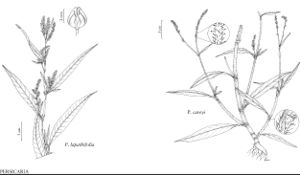Persicaria
Gard. Dict. Abr. ed. 4, vol. 3. 1754.
Herbs, perennial or annual (sometimes suffrutescent in P. wallichii); taprooted or fibrous-rooted; sometimes rhizomatous or stoloniferous. Stems erect or, sometimes, prostrate or scandent, simple or branched, glabrous or pubescent, rarely with recurved prickles. Leaves deciduous, mostly cauline, alternate, petiolate or sessile; ocrea persistent or disintegrating with age and deciduous entirely or distally, usually tan, brown, or reddish, chartaceous or partially to entirely foliaceous, rarely coriaceous proximally and chartaceous distally, glabrous or scabrous to variously pubescent, never 2-lobed distally; blade lanceolate or ovate to hastate or sagittate, margins entire or, rarely, hastately lobed. Inflorescences terminal or terminal and axillary, spikelike, paniclelike, or capitate; peduncle present. Pedicels present or absent. Flowers bisexual (often functionally unisexual in P. amphibia and P. hydropiperoides), 1–14 per ocreate fascicle, base not stipelike; perianth white, greenish white, roseate, red, or purple, campanulate or urceolate, rarely rotate, rarely becoming fleshy in fruit, glabrous, sometimes glandular-punctate, accrescent or nonaccrescent; tepals 4–5, connate 1/4–2/3 their lengths (less than 1/5 their lengths in P. wallichii), petaloid, dimorphic, outer larger than inner; stamens 5–8, filaments distinct or connate basally, outer ones sometimes adnate to perianth-tube, glabrous; anthers yellow, pink, or red, elliptic to ovate; styles 2–3, erect to spreading or reflexed, distinct or connate; stigmas capitate. Achenes included or exserted, brown or dark-brown to black, not winged, discoid, biconvex, 2–3-gonous, or spheroidal, glabrous. Seeds: embryo curved. x = 10, 11, 12.
Contents
Distribution
Nearly worldwide
Discussion
Species ca. 100 (26 in the flora).
Opinions vary widely about the circumscription and infrageneric classification of Persicaria. The concept employed here generally follows L.-P. Ronse Decraene et al. (2000) and K. Haraldson (1978), with five sections recognized in the flora. Aconogonon and Bistorta, which often are included in Persicaria or in Polygonum in the broad sense, are treated here as separate genera.
Selected References
None.
Lower Taxa
Key
Key to the Sections of Persicaria
| 1 | Styles exserted, persistent on achenes; inflorescences spikelike, interrupted | Persicaria sect. Tovara |
| 1 | Styles included, rarely exserted, deciduous; inflorescences capitate, paniclelike, or spikelike, uninterrupted or interrupted | > 2 |
| 2 | Stems with recurved prickles, scandent or, rarely, ascending to erect | Persicaria sect. Echinocaulon |
| 2 | Stems unarmed, usually erect or ascending, rarely prostrate or decumbent | > 3 |
| 3 | Inflorescences capitate; petioles usually winged, auriculate | Persicaria sect. Cephalophilon |
| 3 | Inflorescence spikelike or paniclelike; petioles not winged, not auriculate | > 4 |
| 4 | Inflorescences paniclelike; perianths rotate; tepals connate less than 1/ 5 their lengths | Persicaria sect. Rubrivena |
| 4 | Inflorescences spikelike; perianths campanulate; tepals connate 1/ 2/ 3 their lengths | Persicaria sect. Persicaria |
"/2" is not declared as a valid unit of measurement for this property.


